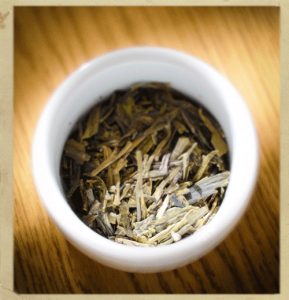We are accused of being obsessed with coffee, to which we retort: "We can be obsessed with other things too, like tea!"

Our Northwest Outreach Coordinator, Joshua Russert, a tea obsessive from way back, gives us an overview of brewing green tea. All true teas come from the same plant; Camelia sinensis. There are two major varieties of the plant- varieties sinensis sinensis and sinensis assamica. And within these two varietals, we can discover a universe of differing colors, leaf types, aroma and flavor sensations. We break down this amazing world of variety by discussing teas within processing categories, which broadly differentiate the leaves by levels of oxidation and manipulation during the post plucking period. These broad categories are White, Green, Oolong, Black and post-fermentation, or, Pu-erh. Here we shall focus on Green tea; what many tea drinkers consider to be the cleanest and most pure form of Camellia sinensis. The appellation Green refers to the level of processing that the leaves have received, with very minimal oxidation. This results in finished leaves that show a green color. This shade of green can range from deep, dark hue to a pale green in some types.

When brewing a cup of green tea, the important factors to remember are that steep time and temperature should be considerably lower than with more fully oxidized (Oolong, Black and Pue-erh) teas. Flavor and sweetness in green tea is determined by a variety of amino acids and natural sugars. Bitterness and astringency are contributed by polyphenols (tannins) that dissolve at 176F (80C). Amino acids dissolve at 140F (60 C). The goal is thus to brew the tea in such a way that we dissolve and capture the sweetness provided by the Amino acids and sugars without simultaneously extracting too many of the tannins, which would overwhelm the sweetness.

In order to get your temperature into the right zone, we recommend bringing your water to just before full boil, then pouring it into a Pyrex measuring cup (or similar heat resistant vessel made for pouring) and placing a thermometer into the water. It should take 2-3 minutes for the water to lower to approximately 170F, a full 5 minutes to reach 140F. It is between these two ranges that we recommend you begin to experiment with how you like your green tea brewed. Starting with a lighter green, like a Yun-Wu Cloudmist Organic Green from China, you can try a lower temperature, and a steeping time for the first pass of around 2 minutes. The sweetness of the Yun-Wu should be present, and if you like a slightly more citrus sensation, you can try steeping longer or using a little slightly higher temperature of water, which will increase the amount of perceived astringency due to a higher level of tannins in the resulting infusion.

With a bigger, deeper green, like a Dragonwell, you might try a higher temperature to start with, and see how the umami and herbaceous flavors change as you lower temperature. Ultimately, you are the scientist here- using temperature and steep time to find the sweet spot that you like best for the green tea you are enjoying.
